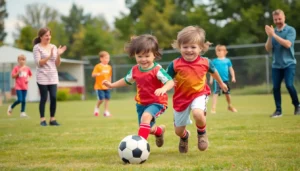Table of Contents
ToggleIn a world where traditional classrooms sometimes feel like a never-ending episode of a dull sitcom, alternative education solutions are stepping in like the quirky best friend who knows how to shake things up. These innovative approaches to learning are not just about dodging the mundane; they’re about unlocking potential in ways that resonate with each individual student.
From online platforms that feel more like gaming than studying to experiential programs that have kids learning through real-world adventures, alternative education is redefining what it means to learn. It’s time to toss aside the one-size-fits-all mentality and embrace a variety of paths that cater to different learning styles. After all, why should education be a snooze-fest when it can be a thrilling ride? Let’s explore the exciting alternatives that are transforming education as we know it.
Overview of Alternative Education Solutions
Alternative education solutions offer diverse approaches that enhance the learning experience outside traditional classroom settings. Online platforms provide interactive learning environments that engage students through gamified experiences and personalized content. Experiential programs immerse students in real-world adventures, enabling them to learn by doing rather than through passive observation.
Communities often support hands-on learning opportunities, such as internships and apprenticeships, which foster practical skills and career readiness. Homeschooling provides flexibility, allowing families to tailor curricula to meet individual student needs based on interests and learning styles. Additionally, micro-schooling combines small class sizes with personalized instruction, nurturing a closely-knit educational atmosphere.
Innovative educational models, like project-based learning, emphasize collaborative effort and creativity. These models encourage students to work on real-life projects that require critical thinking and problem-solving, further preparing them for future challenges. Different learning modalities cater to visual, auditory, and kinesthetic learners, ensuring that all students receive instruction suited to their strengths.
Furthermore, educational technology plays a pivotal role in implementing alternative solutions. Tools like virtual reality and augmented reality create immersive learning experiences that captivate students’ interests. By integrating technology into the curriculum, educators foster a dynamic learning environment that promotes engagement and exploration.
In essence, alternative education solutions prioritize individualized approaches that rekindle a passion for learning. They break down barriers of traditional methods, paving the way for innovative and effective education tailored to diverse needs, ensuring learners thrive in an evolving world.
Types of Alternative Education Solutions
Numerous alternative education solutions offer diverse options, catering to unique learning preferences. Here are some prominent methods.
Montessori Education
Montessori education emphasizes self-directed activity, hands-on learning, and collaborative play. In this approach, students choose their activities in a prepared learning environment. Teachers serve as guides, facilitating exploration instead of delivering traditional lectures. Age-mixed classrooms foster peer learning, encouraging students to teach and learn from each other. The focus on mixed-ability groups nurtures social skills and independence, preparing children for future challenges.
Waldorf Education
Waldorf education integrates academics, artistic expression, and practical skills into a unified curriculum. Emphasis on imagination fuels creativity while focusing on the child’s developmental stages ensures age-appropriateness. Teachers engage students through storytelling, music, and visual arts, promoting holistic understanding. Outdoor activities and nature-based lessons enhance connection with the environment. This approach fosters emotional intelligence alongside intellectual growth.
Online Learning Platforms
Online learning platforms provide flexible and accessible education through digital mediums. Students can engage with interactive content at their own pace. Many programs incorporate gamification, transforming learning into an engaging experience. Teachers facilitate online communities, fostering collaboration and support among learners. Educational resources range from virtual classrooms to comprehensive course offerings, ensuring a wide variety of subjects.
Homeschooling
Homeschooling offers personalized education tailored to family values and student interests. Parents create customized curricula based on individual learning styles and academic goals. This approach allows for flexibility in scheduling and subject focus, catering to each child’s unique pace. Many families participate in co-op groups, enhancing socialization through shared learning experiences. Varied resources, including online courses and local classes, further enrich the homeschooling journey.
Benefits of Alternative Education Solutions
Alternative education solutions enhance the learning experience by prioritizing flexible and personalized approaches. These methods provide opportunities for students to thrive in diverse educational settings.
Flexibility and Customization
Flexibility stands out as a major advantage of alternative education solutions. Many programs allow families to tailor curricula according to unique student needs. Homeschooling epitomizes this customization, offering parents the freedom to design lessons that align with a child’s interests. Micro-schools also capitalize on this flexibility by maintaining small class sizes and individualized instruction. Online platforms add another dimension, letting learners progress at their own pace and engage with material that captivates them. Ultimately, this freedom fosters a learning environment where students can flourish.
Focus on Individual Learning Styles
Focus on individual learning styles differentiates alternative education solutions from traditional methods. Each student possesses distinct strengths and preferences that influence their comprehension and engagement. Innovative models like Montessori and Waldorf emphasize hands-on experiences and artistic expression to cater to varying learning styles. Project-based learning encourages collaboration and critical thinking, allowing students to explore topics in depth. Utilizing educational technology also enhances this focus, enabling tailored experiences through virtual reality and interactive resources. By prioritizing personalized approaches, alternative education solutions support each learner’s unique journey.
Challenges Faced by Alternative Education Solutions
Alternative education solutions encounter various challenges that affect their implementation and reach. These challenges can impact accessibility, regulatory standards, and acceptance.
Accessibility Issues
Accessibility issues arise in alternative education solutions, particularly for underserved communities. Not all families possess equal access to resources, including technology and information about options. Students with disabilities often face additional barriers in non-traditional settings, limiting their opportunities. Locations of alternative education programs vary, making travel difficult for some families. Affordability also presents a challenge; many programs come with tuition costs, which can deter participation from lower-income households. Efforts to create equitable access remain necessary to ensure that all students benefit from diverse educational solutions.
Regulatory and Accreditation Challenges
Regulatory and accreditation challenges create significant hurdles for alternative education solutions. Each state has different requirements for licensing, which can complicate the establishment of new programs. Many alternative schools operate outside traditional district regulations, leading to uncertainty about compliance with educational standards. Tracking student progress and ensuring accountability becomes problematic in unchartered educational landscapes. Accreditation also remains a critical factor; without recognized accreditation, students may face difficulties transferring credits or gaining acceptance in higher education institutions. Addressing these challenges is essential for the longevity and credibility of alternative education initiatives.
Alternative education solutions represent a transformative shift in how students engage with learning. By embracing diverse methodologies and technologies, these approaches cater to individual needs and preferences. They foster creativity critical thinking and real-world skills that prepare learners for future challenges.
While challenges such as accessibility and regulatory hurdles exist, the potential for personalized education remains promising. As these innovative models continue to evolve and gain recognition, they offer hope for a more inclusive and engaging educational landscape. The journey toward redefining education is just beginning, and embracing these alternatives could lead to a brighter future for learners everywhere.






